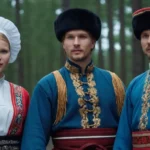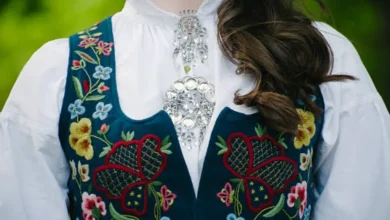Norwegian traditional clothing, famously embodied in the bunad, is a vibrant symbol of the nation’s history, regional pride, and artistic craftsmanship. From festive wear to practical garments of the past, these clothes tell stories of cultural identity and deep connection to Norway’s natural landscape.
Understanding the Essence of Norwegian Traditional Clothing
What is a Bunad?
The bunad is Norway’s traditional costume, representing the unique culture of its many regions. Each design reflects local traditions, colors, and craftsmanship, making every bunad a personal and communal emblem.
A Journey Through History
Rooted in rural costumes of the 18th and 19th centuries, bunads were initially designed for practicality and elegance. Over time, they transformed into cherished attire for special occasions and cultural celebrations.
Core Elements of Norwegian Traditional Attire
1. The Bunad: Norway’s Iconic Costume
Bunads are highly detailed and meticulously crafted, with distinct features depending on the wearer’s gender and region.
See also Exploring Traditional Clothing in Denmark: A Journey Through Danish Heritage
Exploring Traditional Clothing in Denmark: A Journey Through Danish HeritageWomen’s Bunad
- Blouses: White linen, often with intricate lace or embroidered detailing.
- Skirts and Aprons: Long, flowing, and richly patterned to reflect the local area.
- Bodices and Shawls: Embellished with embroidery and often paired with woolen or silk scarves.
- Jewelry: Silver brooches and clasps add an extra layer of beauty and tradition.
Men’s Bunad
- Shirts: Typically white and adorned with subtle embroidery.
- Trousers and Breeches: Made of durable wool, tailored for an elegant fit.
- Jackets and Waistcoats: Often decorated with buttons and embroidery, reflecting regional styles.
- Accessories: Includes silver belts and wide-brimmed hats.
2. Regional Styles
Each Norwegian region boasts its own unique bunad, offering a window into the area’s history and culture.
Telemark
- Famous for bright embroidery and detailed floral designs.
- Characterized by vivid, bold colors.
Hardanger
- Known for intricate white embroidery and lace, often paired with stunning silver pieces.
Nordland
- Distinguished by its vibrant blue and green palette.
- Reflects the maritime traditions of the northern coastal areas.
3. Accessories and Footwear
- Silver Jewelry: Brooches, buckles, and clasps are essential parts of the bunad, symbolizing both status and regional identity.
- Shoes: Black leather shoes, frequently adorned with silver buckles.
- Headdresses: Women’s headgear varies by region, ranging from simple scarves to ornate crowns.
The Role of Norwegian Traditional Clothing in Celebrations
National Pride on May 17th
On Norway’s Constitution Day, bunads fill the streets as a powerful display of cultural pride and unity. This annual celebration is a testament to the enduring relevance of traditional attire.
Weddings and Milestones
From weddings to baptisms, bunads hold a special place in Norway’s most significant life events, symbolizing family ties and cultural heritage.
Folk Festivals
Traditional clothing is a key feature of festivals celebrating Norwegian music, dance, and folklore, emphasizing the connection between attire and tradition.
See also Exploring Traditional Clothing in Finland: A Celebration of Heritage
Exploring Traditional Clothing in Finland: A Celebration of HeritagePreserving and Revitalizing Norwegian Clothing Traditions
Efforts to Safeguard the Bunad
Organizations like the Norwegian Institute for Bunad and Folk Costume work tirelessly to preserve these garments. Their initiatives include educational programs and exhibitions showcasing regional styles and techniques.
Modern Interpretations
Contemporary designers draw inspiration from traditional bunads, integrating elements like embroidery and natural fabrics into modern apparel, ensuring these traditions evolve alongside Norwegian society.
The Craftsmanship Behind Norwegian Traditional Clothing
Embroidery: A Labor of Love
Hand-stitched patterns on bunads depict themes from nature and folklore, reflecting the skill and artistry of Norwegian artisans.
Quality Materials
Garments are made using high-quality wool, linen, and silk, ensuring their durability and elegance.
The Role of Silverwork
Silver jewelry, a hallmark of Norwegian traditional attire, is intricately crafted, often passed down as family heirlooms.
Where to Experience Norwegian Traditional Clothing
Museums
- The Norwegian Museum of Cultural History: Offers an in-depth look at bunad history and regional variations.
- Maihaugen Open-Air Museum: Features exhibits of traditional clothing in historical settings.
Festivals
- Constitution Day Parades: The ideal opportunity to see a variety of bunads in use.
- Folk Music and Dance Events: Celebrate Norwegian culture with performances in traditional attire.
Workshops and Boutiques
Local artisans and boutiques provide opportunities to purchase authentic bunads and learn about their history and craftsmanship.
A Living Tradition: Norwegian Clothing’s Enduring Legacy
Traditional Norwegian clothing, especially the iconic bunad, continues to be a vibrant symbol of cultural pride and identity. Whether worn during national celebrations or passed down as heirlooms, these garments reflect Norway’s rich heritage and the timeless beauty of its craftsmanship. By embracing these traditions, Norwegians maintain a profound connection to their history while inspiring future generations to cherish their cultural roots.

